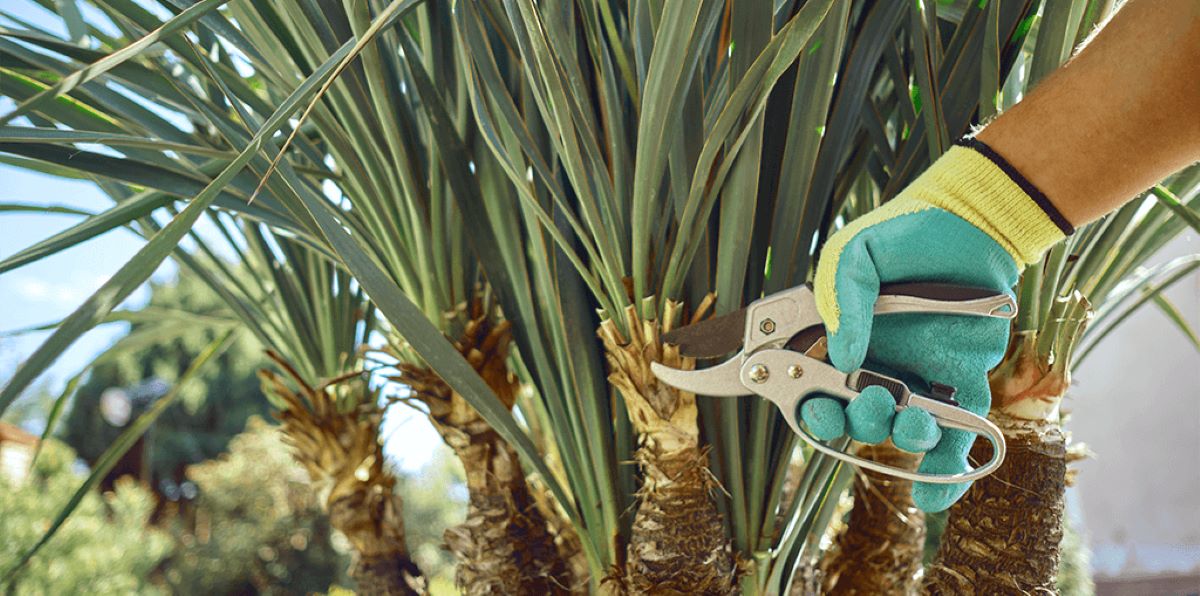Home>Gardening News and Trends>Latest News>How Tall Do Palm Trees Grow


Latest News
How Tall Do Palm Trees Grow
Modified: February 7, 2024
Discover the latest news about how tall palm trees can grow. Learn fascinating insights and find out what factors contribute to their remarkable height.
(Many of the links in this article redirect to a specific reviewed product. Your purchase of these products through affiliate links helps to generate commission for Chicagolandgardening.com, at no extra cost. Learn more)
Table of Contents
Introduction
When it comes to iconic symbols of tropical paradise, palm trees are at the top of the list. With their towering heights and gracefully swaying fronds, these majestic trees create an atmosphere of relaxation and serenity. But have you ever wondered just how tall palm trees can grow?
Palm trees belong to the family Arecaceae and are found in various parts of the world, including tropical and subtropical regions. There are over 2,500 known species of palm trees, each with its own unique characteristics and growth patterns.
The height of a palm tree can vary greatly depending on the species, environmental conditions, and other factors. Some palm trees are relatively short and compact, while others can reach astonishing heights, towering over their surroundings. In this article, we will explore the different types of palm trees, factors affecting their height, and some of the tallest palm trees found around the world.
Understanding how palm trees grow and what influences their height can help us appreciate these magnificent trees even more. So, let’s delve into the fascinating world of palm tree growth and discover just how tall these natural wonders can actually be.
Types of Palm Trees
Palm trees come in a wide variety of shapes, sizes, and appearances. Each species has its own unique characteristics, making them easily distinguishable. Here are some popular types of palm trees:
- Date Palm (Phoenix dactylifera): This iconic palm tree is well-known for its delicious and nutritious fruits known as dates. Date palms have a tall and slender trunk with graceful fronds at the top.
- Coconut Palm (Cocos nucifera): The coconut palm is often associated with sandy beaches and tropical islands. With its distinct curved trunk and large, feathery fronds, it is one of the most recognizable palm trees.
- Queen Palm (Syagrus romanzoffiana): Native to South America, the queen palm is a popular choice for landscaping due to its elegant appearance. It has a straight trunk and long arching fronds that give a regal touch to any environment.
- Areca Palm (Dypsis lutescens): Also known as the butterfly palm, the areca palm features slender trunks with feathery, arching fronds. It is a popular indoor plant known for its air-purifying qualities.
- Fan Palm (Washingtonia robusta): This palm tree gets its name from its fan-shaped leaves. With a tall and slender trunk, the fan palm is commonly seen lining the streets of many cities around the world.
These are just a few examples of the diverse array of palm tree species. Each has its own unique charm and contributes to the beauty of our landscapes and natural habitats. Understanding the different types of palm trees enhances our appreciation for the variety and versatility of the plant kingdom.
Factors Affecting Palm Tree Height
Several factors influence the height that palm trees can reach. Here are some key factors that play a role in determining the ultimate height of palm trees:
- Species: The species of palm tree itself is one of the most significant factors in determining height. Different species have different growth patterns and natural heights. Some palm trees, like the coconut palm, can grow to be very tall, reaching heights of up to 100 feet or more.
- Environmental Conditions: The environment in which a palm tree grows can greatly affect its height. Factors such as temperature, humidity, sunlight, and soil conditions all play a role in determining how tall a palm tree can grow. Palm trees thrive in tropical and subtropical climates, where they can receive adequate sunlight and moisture.
- Nutrition and Water Supply: Proper nutrition and a sufficient water supply are essential for palm tree growth. Palm trees require specific nutrients, including potassium, magnesium, and nitrogen, to support healthy growth. Lack of these nutrients can stunt the tree’s growth and limit its height potential.
- Age: Age plays a role in determining the height of palm trees. Young palm trees are typically shorter compared to mature ones. As palm trees continue to grow and develop, they gradually gain height and reach their full potential over the course of several years.
- Pruning and Maintenance: Proper pruning and maintenance practices can also impact the height of palm trees. Regular pruning helps to remove dead or damaged fronds, allowing the tree to focus its energy on new growth. This can contribute to healthier and taller palm trees.
It’s important to note that while these factors generally influence palm tree height, there may be variations within each species and individual tree. Each palm tree has its unique growth pattern and potential, influenced by a combination of these factors. By understanding these influences, we can create optimal conditions for palm tree growth and appreciate the remarkable heights they can reach in their natural habitats.
Tall Palm Trees around the World
Palm trees are known for their impressive heights, and there are several notable examples of tall palm trees around the world. Let’s take a look at some of these towering giants:
- Jubaea chilensis: Also known as the Chilean wine palm, this species holds the record for the tallest palm tree in the world. Native to Chile, it can reach heights of up to 80 feet or more.
- Ceroxylon quindiuense: Found in the Andean region of South America, the wax palm is recognized as the national tree of Colombia. It can grow to heights of up to 200 feet, making it one of the tallest palm trees globally.
- Phytelephas aequatorialis: Commonly known as the Panama hat palm, this species is native to Ecuador. It can reach heights of up to 100 feet and is highly valued for its ivory-colored seeds, which are used to make Panama hats.
- Borassus flabellifer: Also called the toddy palm, this species is found in various parts of Asia and Africa. It can grow to heights of up to 80 feet and is known for its versatility, as different parts of the tree are used for various purposes like thatching, making sugar, and producing alcoholic beverages.
These are just a few examples of the remarkable heights that palm trees can reach in different parts of the world. Each of these tall palm trees contributes to the unique landscapes and ecosystem of their respective regions, adding a touch of grandeur and natural beauty.
How Palm Trees Grow
Understanding the growth process of palm trees can provide insight into their impressive heights and unique physical characteristics. Here’s a closer look at how palm trees grow:
1. Germination: Palm trees start their journey as seeds. When conditions are favorable, the seeds germinate, usually in a sandy or well-drained soil environment.
2. Root Development: The seed begins to produce roots, anchoring the young palm tree into the soil. These roots absorb water and nutrients from the ground to support growth.
3. Leaf Emergence: As the root system establishes, the first few leaves, known as cotyledon leaves or seed leaves, emerge from the top of the trunk. These leaves provide initial nourishment to the growing palm tree.
4. Trunk Formation: The trunk of a palm tree is unique in that it does not grow in girth like the trunks of other trees. Instead, it elongates and retains its cylindrical shape. The trunk is composed of layers of fibers, providing strength and flexibility to withstand wind and other environmental conditions.
5. Frond Growth: As the palm tree matures, it continues to produce new fronds, also known as leaves. These fronds are essential for photosynthesis, the process by which the tree converts sunlight into energy. Palm tree fronds can range in size, shape, and appearance, depending on the species.
6. Flowering and Fruit Production: Palm trees are generally dioecious, meaning there are male and female trees. The male trees produce flowers that release pollen, which is carried by the wind to the female flowers. The fertilized female flowers develop into fruits, such as coconuts or dates, each containing seeds for future generations of palm trees.
7. Continued Growth: Palm trees have an indeterminate growth pattern, meaning they can continue to grow throughout their lifespan. However, the rate of growth may slow down as the tree reaches maturity. Some palm trees can live for several decades, while others can survive for centuries.
The growth process of palm trees is a remarkable journey that allows them to reach astonishing heights and become an integral part of tropical and subtropical landscapes around the world.
Growth Rate of Palm Trees
The growth rate of palm trees varies depending on several factors, including species, environmental conditions, and overall health of the tree. While palm trees are known for their slow growth compared to other trees, some species can grow at a relatively fast rate. Here are some factors that influence the growth rate of palm trees:
1. Species: Different palm tree species have varying growth rates. Some palm trees, such as the Royal Palm (Roystonea regia) or the Queen Palm (Syagrus romanzoffiana), can grow relatively quickly, adding several feet to their height each year. On the other hand, species like the Ponytail Palm (Beaucarnea recurvata) have a slower growth rate.
2. Environmental Conditions: The environment plays a crucial role in the growth rate of palm trees. Factors such as temperature, sunlight exposure, soil quality, and water availability affect how quickly a palm tree can grow. In regions with optimal conditions, palm trees tend to have faster growth rates compared to areas with less favorable environments.
3. Age: Young palm trees typically have a faster growth rate than older, more mature trees. As a palm tree reaches maturity, its growth rate may slow down. However, even mature palm trees continue to grow, albeit at a slower pace.
4. Health and Care: Palm trees that receive proper care and nutrition tend to have a better growth rate. Adequate water, fertilization, and preventive measures against pests or diseases contribute to the overall health of the tree and promote more robust growth.
It’s important to note that, in general, palm trees have a slower growth rate compared to many other tree species. While some palm trees can reach impressive heights over time, their growth is gradual and steady. Patience is key when it comes to the growth of palm trees, as it can take several years or even decades for them to reach their full potential.
By understanding the factors that influence the growth rate of palm trees, we can create suitable conditions to promote their healthy development and appreciate their unique growth patterns.
Techniques to Promote Growth in Palm Trees
Palm trees are unique and beautiful additions to any landscape, and promoting their growth is essential for ensuring their health and vitality. Here are some techniques to encourage optimal growth in palm trees:
- Provide Adequate Water: Palm trees require regular watering, especially during hot and dry periods. Keep the soil consistently moist, but avoid overwatering, as excessive moisture can lead to root rot. Use a drip irrigation system or water deeply and infrequently to encourage deep root growth.
- Fertilize Regularly: Palm trees benefit from regular fertilization to replenish essential nutrients. Use a slow-release palm fertilizer that contains balanced ratios of nitrogen, phosphorus, and potassium, along with micronutrients. Apply the fertilizer according to the manufacturer’s instructions, usually during the growing season.
- Prune Wisely: Pruning palm trees helps maintain their health and aesthetics. Remove dead, damaged, or diseased fronds using sterile pruning tools to prevent the spread of diseases. Avoid excessive pruning, as it can stress the tree and inhibit growth. Leave a slight collar when trimming fronds to avoid damaging the trunk.
- Protect from Pests and Diseases: Regularly inspect palm trees for signs of pests, such as spider mites or scale insects. If infestations occur, treat them immediately using appropriate insecticides or natural pest control methods. Additionally, monitor for common palm diseases such as Fusarium wilt and Ganoderma, and take necessary preventive measures.
- Ensure Proper Sunlight Exposure: Palm trees thrive in full sunlight. Ensure they are planted in a location where they receive at least 6 to 8 hours of direct sunlight each day. Insufficient sunlight can slow down growth and make the tree more susceptible to diseases.
- Maintain Well-Draining Soil: Palm trees prefer well-draining soil to prevent waterlogging. Sandy or loamy soil types are ideal for palm tree growth. If your soil is heavy and clayey, consider amending it with organic matter to improve drainage.
- Monitor and Adjust Irrigation: Pay attention to the moisture levels in the soil and adjust irrigation accordingly. Too much or too little water can negatively impact palm tree growth. Consider using a soil moisture meter to accurately gauge when to water.
By implementing these techniques, you can create the optimal conditions for palm tree growth and ensure their overall well-being. Remember that consistent care and attention are key to helping palm trees reach their full potential and provide beauty and shade in your surroundings.
Conclusion
Palm trees, with their majestic heights and graceful fronds, captivate our imaginations and create a sense of tropical paradise. Understanding the factors that affect their height, the different types of palm trees, and the techniques to promote their growth allows us to appreciate these remarkable trees even more.
From the towering Chilean wine palm to the iconic coconut palm, palm trees come in a wide variety of species, each with its own unique characteristics and growth patterns. Factors such as species, environmental conditions, nutrition, and maintenance practices all play a role in determining how tall a palm tree can grow.
While palm trees have a slower growth rate compared to other tree species, they are resilient and continue to grow throughout their lifespans. Providing adequate water, regular fertilization, proper pruning, and protection against pests and diseases are essential for ensuring optimal growth in palm trees.
By creating ideal growing conditions and taking care of palm trees, we can witness their gradual and magnificent growth. Whether they stand tall as landmarks in their natural habitats or adorn our landscapes, palm trees provide us with both visual beauty and a sense of peace.
So next time you come across a majestic palm tree, take a moment to appreciate its growth journey and the natural wonders it brings. The tall heights and green fronds of palm trees remind us of the beauty and diversity found in our natural world.










